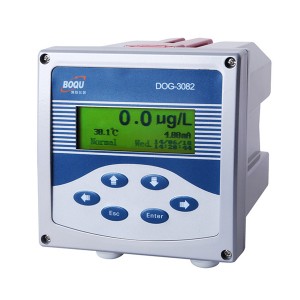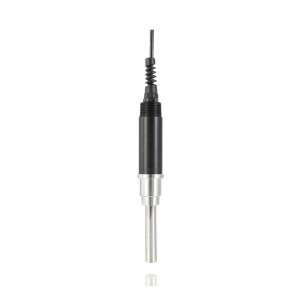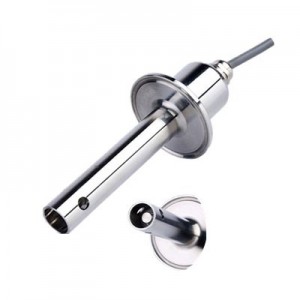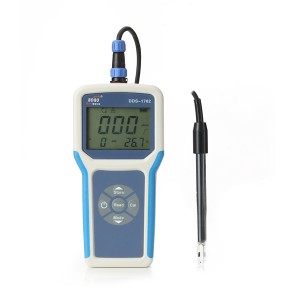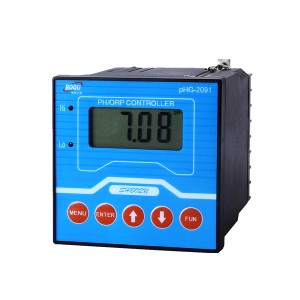Features
New design, Aluminium shell, Metal texture.
All the data are displayed in English. It can be easily operated:
It has a complete English display and elegant interface: Liquid crystal display module with high resolution is adopted. All the data, status and operation prompts are displayed in English. There is no symbol or code that is
defined by the manufacturer.
Simple menu structure and text-type man-instrument interaction: Compared with traditional instruments, DOG-3082 has many new functions. As it adopts classified menu structure, which is similar to that of a computer,
it is clearer and more convenient. It is not necessary to remember the operation procedures and sequences. It can be operated according to the prompts on the screen without the guidance of an operation manual.
Multi-parameter display: The oxygen concentration value, input current (or output current), temperature values, time and status can be displayed on the screen at the same time. The main display can show the oxygen
concentration value in a 10 x 10mm size. As the main display is eye-catching, the displayed values can be seen from a long distance away. Six sub-displays can display such information as the input or output current,
temperature, status, week, year, day, hour, minute and second, so as to adapt to different users’ habits and to conform with different reference times set by the users.
| Measuring range: 0~100.0ug/L; 0~20.00 mg/L (automatic switching); (0-60℃);(0-150℃)Option |
| Resolution: 0.1ug/L; 0.01 mg/L; 0.1℃ |
| Intrinsic error of the whole instrument: ug/L: ±l.0%FS; mg/L: ±0.5%FS, temperature: ±0.5℃ |
| Repeatability of the indication of the whole instrument: ±0.5%FS |
| Stability of the indication of the whole instrument: ±1.0%FS |
| Automatic temperature compensation range: 0~60℃, with 25℃ as the reference temperature. |
| Response time: <60s (98% and 25℃ of the final value) 37℃: 98% of the final value < 20 s |
| Clock accuracy: ±1 minute/month |
| Output current error: ≤±l.0%FS |
| Isolated output: 0-10mA (load resistance <15KΩ); 4-20mA (load resistance <750Ω) |
| Communication interface: RS485 (optional) (Double power for option) |
| Data storage capacity: l month (1 point/5 minutes) |
| Saving time of data under a continuous power-failure condition: 10 years |
| Alarm relay: AC 220V, 3A |
| Power supply: 220V±10% 50±1HZ, 24VDC(option) |
| Protection: IP54, Aluminium shell |
| Size: secondary meter: 146 (length) x 146 (width) x 150(depth) mm; |
| dimension of the hole: 138 x 138mm |
| Weight: 1.5kg |
| Working conditions: ambient temperature: 0-60℃; relative humidity <85% |
| The connection tubes for inlet and outlet water: Pipes and hoses |
Dissolved oxygen is a measure of the amount of gaseous oxygen contained in water. Healthy waters that can support life must contain dissolved oxygen (DO).
Dissolved Oxygen enters water by:
direct absorption from the atmosphere.
rapid movement from winds, waves, currents or mechanical aeration.
aquatic plant life photosynthesis as a by-product of the process.
Measuring dissolved oxygen in water and treatment to maintain proper DO levels, are crucial functions in a variety of water treatment applications. While dissolved oxygen is necessary to support life and treatment processes, it can also be detrimental, causing oxidation that damages equipment and compromises product. Dissolved oxygen affects:
Quality: The DO concentration determines the quality of source water. Without enough DO, water turns foul and unhealthy affecting the quality of the environment, drinking water and other products.
Regulatory Compliance: To comply with regulations, waste water often needs to have certain concentrations of DO before it can be discharged into a stream, lake, river or waterway. Healthy waters that can support life must contain dissolved oxygen.
Process Control: DO levels are critical to control biological treatment of waste water, as well as the biofiltration phase of drinking water production. In some industrial applications (e.g. power production) any DO is detrimental for steam generation and must be removed and its concentrations must be tightly controlled.


